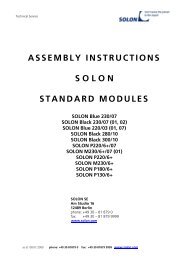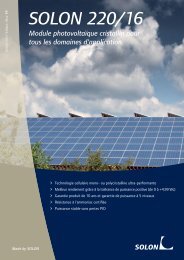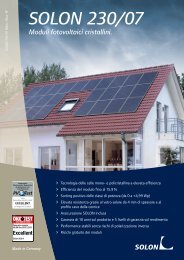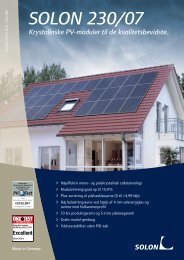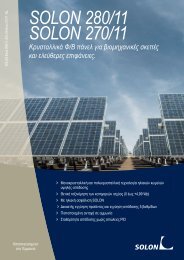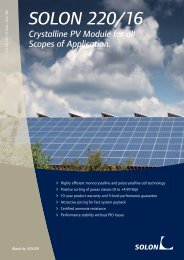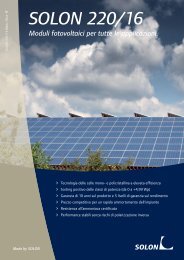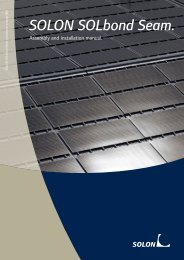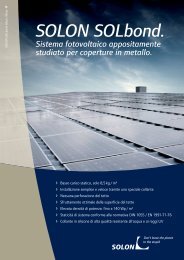Potential Induced Degradation Of solar Cells And panels - Solon
Potential Induced Degradation Of solar Cells And panels - Solon
Potential Induced Degradation Of solar Cells And panels - Solon
Create successful ePaper yourself
Turn your PDF publications into a flip-book with our unique Google optimized e-Paper software.
Figure 8: Dependency of PID on SiN RI and thickness.<br />
For ARC deposition the third parameter having an impact<br />
on PID was found to be the homogeneity of the resulting<br />
SiN layer which was recognized to be clearly different for<br />
various SiN deposition methods.<br />
The observations made for the role of the SiN parameter<br />
concerning PID can be explained by the different<br />
conductivity of the resulting layer for different parameter<br />
settings making trapping of charges more or less likely.<br />
5.1.2 Wafer material<br />
Also the wafer material has been identified to be<br />
another crucial factor regarding PID. The most<br />
significant parameter in this respect is the base resistivity.<br />
As presented in Figure 9 an increasing base resistivity is<br />
resulting in decreasing PID. Higher base resistivity<br />
representing lower base doping leads to a wider depletion<br />
layer at the junction when the emitter doping is held<br />
constant. Accordingly shunting of the junction is less<br />
likely.<br />
Figure 9: Dependency of PID on base resistivity<br />
Within different experiments with cell suppliers where<br />
cells have been produced at constant cell processing<br />
parameters utilizing different wafer suppliers a significant<br />
batch dependence has been found. This could hint on<br />
systematic variation of certain wafer properties relevant<br />
for PID.<br />
Lower quality silicon or comparably high concentration<br />
of crystal defects seem to increase the tendency of PID<br />
but results have to be further verified.<br />
5.1.3 Emitter<br />
Since the emitter process clearly influences the width<br />
of the depletion layer it can definitely be influencing the<br />
probability for shunting the PN-junction and therefore<br />
the tendency for PID. As it can be seen in Figure 10 with<br />
increasing emitter sheet resistivity PID is also increasing.<br />
Figure 10: Dependency of PID on emitter sheet<br />
resistance.<br />
Beside the trend in <strong>solar</strong> industry to increase the emitter<br />
sheet resistivity for <strong>solar</strong> cells it can be additionally<br />
increased by new process steps such as emitter back<br />
etching or the introduction of the selective emitter<br />
process.<br />
This example shows that process variations within the<br />
cell process which are thought to be of no relevance for<br />
the later application can lead to degradation when the cell<br />
are exposed to an external potential later in the field.<br />
Since there are many factors on cell level impacting PID<br />
there is no easy distinction between cells more or less<br />
prone to PID just by IV characterization. However, due<br />
to the PID mechanism and the impacting factors<br />
discussed above there are some IV characteristics that<br />
hint on lower PID sensitivity: high shunt resistance and<br />
low reverse bias current. Both parameters are depending<br />
on local defects and base resistivity.<br />
According to our recent results the most effective path for<br />
prevention of PID on cell level is the selection of suitable<br />
parameters (RI and thickness) for ARC deposition.<br />
5.2 Panel level<br />
Since PID is not yet completely excluded on cell<br />
level for all industrial <strong>solar</strong> cells being produced today it<br />
is certainly worthwhile to take a closer look on the<br />
possibilities to minimize or exclude PID on the panel<br />
level even in case of <strong>solar</strong> cells prone to PID. In Figure<br />
11 there are shown EL images for a <strong>solar</strong> panel before<br />
and after the PID test (1000V, 100hr).<br />
According to the image after the test some cells degrade<br />
strongly - finally being short circuited - while others<br />
appear to be stable. Being the cell the origin for PID this<br />
observation can be explained by variation of certain cell<br />
properties relevant for PID as discussed in the chapter<br />
above.



